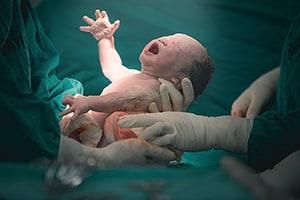Congenital birth defects are somewhat different from “birth injuries.” A birth injury is a something that results from so sort of event during pregnancy or delivery. A congenital birth defect is a physical or functional abnormality present from birth and caused by genetic inheritance or chromosomal disorders. Birth defects are not the result of any events or occurrence during pregnancy or birth.
Most Common Birth Defects
Congenital birth defects are reported in approximately 3% of all births in the U.S. each year. There are many different types and birth defects ranging from very mild physical deformation to life-threatening heart issues. Below is a summary of the most common type of congenital birth defects:
- Congenital Heart Defects: congenital heart conditions are the most common type of birth defect. Approximately 1 of every 100 babies in the U.S. is born with some type of heart defect. Heart defects occur when the baby’s heart does not grow and develop normally during the early phases of gestation. There are dozens of different types of heart defects most of which are not serious. The 7 most serious heart defects, those that impact the shape and function of the heart, are grouped together under the term Critical Congenital Heart Disease (CCHD). Just under 5,000 babies a year are diagnosed with CCHD. CCHD is very serious and it is the 2nd leading cause of infant mortality behind only premature birth. Most heart defects are genetically inherited.
- Down Syndrome: Down syndrome is a chromosomal birth defect. Chromosomes are like little group packets of genetic material which combine to form the blueprint for each baby’s body. Normal babies are born with 46 chromosome pairs. Down syndrome occurs in babies that are born with an extra chromosome copy. The presence of the extra chromosome causes various abnormalities in the development of the brain and body which result in low mental capacity and the other characteristic physical symptoms of Down syndrome.
- Orofacial Clefts: cleft lip/cleft palate (orofacial clefts) are common congenital birth defects caused by abnormal physical development of the baby’s lip or mouth during pregnancy. Cleft lip occurs when the tissues that form the lips do not properly fuse together during pregnancy. The result is a gap or slit in the lip that can vary in size and cause very abnormal physical appearance. A cleft palate is the same condition but it occurs in the upper roof of the mouth. About 7,000 babies are born each year with cleft lip or cleft palate. Orofacial clefts are believed to be caused by a combination of genetic predisposition and environmental factors. Treatment for orofacial clefts usually involves corrective surgery.
- Spina Bifida: spina bifida is a type of congenital birth defect that results from developmental abnormalities in the spinal cord and bones of the spine. Spina bifida is the most common type of birth defect originating from the neural tube. The neural tube is the part of the embryo that eventually forms into the spine. Normal the neural tube is supposed to form in early pregnancy and then close by the end of the first month. With spina bifida, the neural tube fails to close as its supposed to and defects develop in the spine and cord. There several different types of spina bifida, all of which range in severity. Depending on the type and severity, spina bifida can cause not only physical disabilities (but also mental disabilities. The cause of spina bifida is still not fully understood, however, current research suggests that it may involve a combination of genetics and environmental factors.
- Club Foot: Clubfoot is a common physical birth defect characterized by an abnormal twisting of the foot into a non-functional shape. Babies born with clubfoot have feet that point inward at the ankle so that the sole of the foot basically faces the other foot. Clubfoot is less common than other congenital birth defects, affecting only 1 out of every 1,000 babies born in the U.S. Clubfoot is believed to be a genetically inherited condition.
- Phenylketonuria: This is a fairly rare, genetically inherited birth defect in which the body is not able to break down the amino acid called phenylalanine. Phenylalanine is released from the digestion of certain proteins and artificial sweeteners. The resulting buildup of phenylalanine in the body can be very dangerous.
- Edwards’ Syndrome: Also known as Trisomy 18, Edwards’ syndrome is a chromosomal defect much like down syndrome. Edwards syndrome is also caused by an extra copy of chromosome 18, and it less common than down syndrome. Edwards syndrome is often a fatal birth defect. More than half of all babies born with Edwards syndrome die within the first week of life and less than 10% live more than 1 year.
- Bell’s Palsy: Bell’s Palsy is not exactly congenital — we do not know exactly what causes it. Bell’s palsy is a temporary weakness in the child’s causing a sometimes distorted face. It is usually temporary.
Exercising (except for certain high-risk pregnancies) and getting your flu shot while pregnant are highly recommended by medical professionals and do not cause birth defects.
